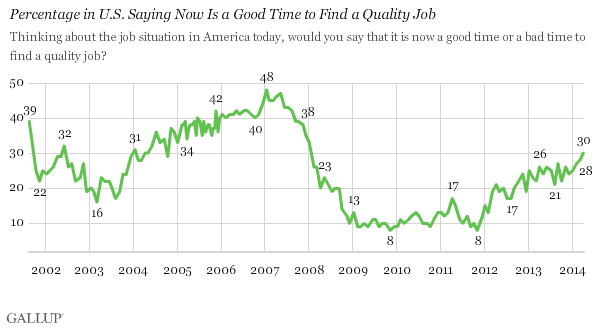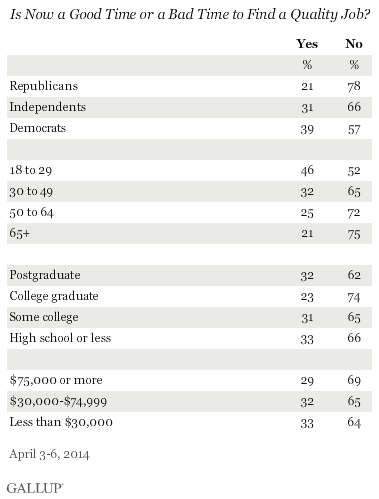PRINCETON, NJ -- Thirty percent of Americans now say it a good time to find a quality job, continuing the positive trend on this indicator since it reached its recent low point of 8% in 2011. This is the most optimistic Americans have been about the job market since early 2008.

Gallup first asked this question in August 2001, when 39% responded affirmatively. Gallup has updated it monthly since October of that year; the most recent data come from Gallup's April 3-6 Economy and Personal Finance survey.
Americans' perceptions of the job market have undergone several distinct changes since 2001. After souring between mid-2002 and early 2003, attitudes began trending more positive in late 2003 and continued on an upward trajectory until 2007, when almost half of Americans said it was a good time to find a quality job.
Americans' views of the job market began to deteriorate after that, and as the Great Recession took hold in 2008 and 2009, plummeted to record low points in 2009 and 2011. Optimism has generally been rising since then.
On an absolute basis, the 30% now calling it a good time to find a quality job is still rather grim; 66% of Americans say it is not a good time to find a quality job. Still, Americans' improving views of the job market fit with data showing that they are a bit more positive about their personal finances and with the observed improvement in workers' perceptions of hiring and firing at their places of employment.
Views of the job market are relatively unaffected by Americans' own personal income and education levels, but they are more strongly related to age and partisanship. Younger Americans are the most positive of any age group about the outlook on finding a quality job, despite higher unemployment rates for young people and news reports of young college graduates having difficulty finding jobs.

Democrats and independents remain more positive than Republicans. This finding reflects a basic pattern in American public opinion on the economy: Republicans were more positive about the job market during the presidency of George W. Bush, while Democrats have been more positive in the years since President Barack Obama took office.
Bottom Line
While Americans' views of the job market continue their gradual recovery from the depths to which they descended several years ago, two-thirds of Americans still say that it is not a good time to find a quality job, underscoring the difficult path to a full economic recovery.
Survey Methods
Results for this Gallup poll are based on telephone interviews conducted April 3-6, 2014, with a random sample of 1,026 adults, aged 18 and older, living in all 50 U.S. states and the District of Columbia.
For results based on the total sample of national adults, the margin of sampling error is ±4 percentage points at the 95% confidence level.
Interviews are conducted with respondents on landline telephones and cellular phones, with interviews conducted in Spanish for respondents who are primarily Spanish-speaking. Each sample of national adults includes a minimum quota of 50% cellphone respondents and 50% landline respondents, with additional minimum quotas by time zone within region. Landline and cellular telephone numbers are selected using random-digit-dial methods. Landline respondents are chosen at random within each household on the basis of which member had the most recent birthday.
Samples are weighted to correct for unequal selection probability, nonresponse, and double coverage of landline and cell users in the two sampling frames. They are also weighted to match the national demographics of gender, age, race, Hispanic ethnicity, education, region, population density, and phone status (cellphone only/landline only/both, and cellphone mostly). Demographic weighting targets are based on the most recent Current Population Survey figures for the aged 18 and older U.S. population. Phone status targets are based on the most recent National Health Interview Survey. Population density targets are based on the most recent U.S. census. All reported margins of sampling error include the computed design effects for weighting.
In addition to sampling error, question wording and practical difficulties in conducting surveys can introduce error or bias into the findings of public opinion polls.
View survey methodology, complete question responses, and trends.
For more details on Gallup's polling methodology, visit www.gallup.com.
